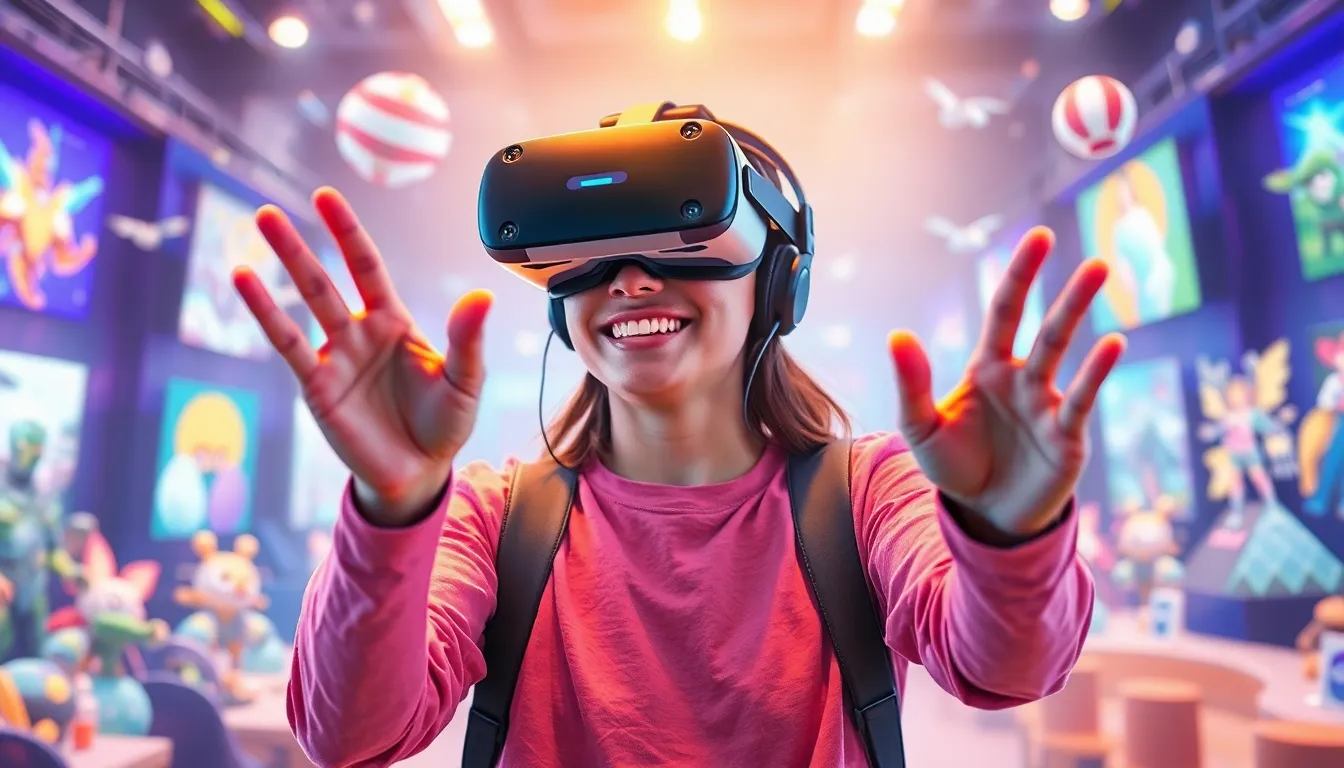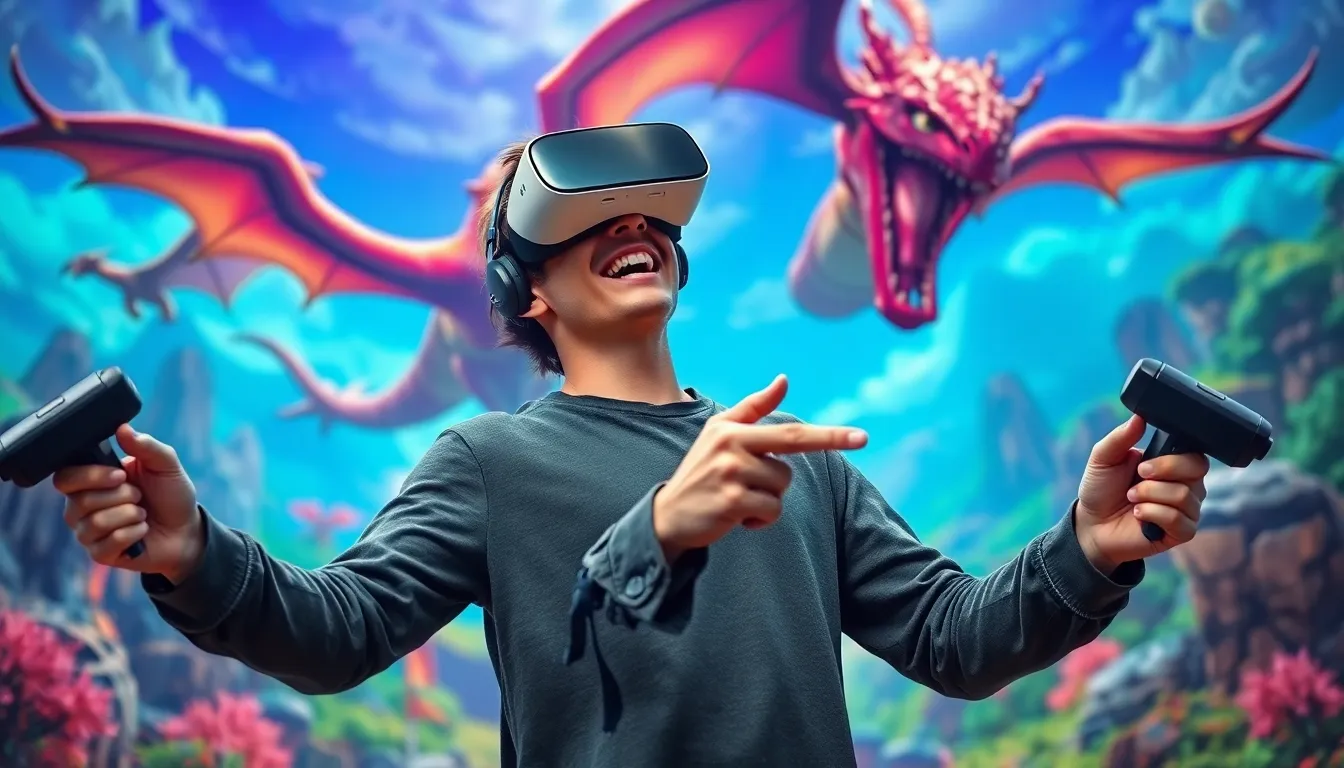Imagine slipping into a world where gravity’s just a suggestion and dragons are your new best friends. Virtual reality gaming isn’t just a pastime; it’s a ticket to realms where the impossible becomes your daily grind. From battling fierce monsters to solving intricate puzzles, VR transports players into experiences that are as exhilarating as they are immersive.
Table of Contents
ToggleOverview of Virtual Reality Game Experience
Virtual reality gaming immerses players in vibrant digital environments that often feel indistinguishable from reality. Players navigate expansive worlds, experiencing lifelike interactions that elevate traditional gaming into a multi-sensory adventure. Motion tracking technology allows for seamless movement, enhancing the sense of presence when engaging with game elements.
Environmental sounds play a pivotal role in the overall experience. These realistic audio effects create an atmosphere that further draws players into the game. Graphics quality also significantly impacts immersion, as advanced rendering techniques produce stunning visuals that captivate users.
Multiplayer capabilities add another layer to virtual reality gaming. Gamers can connect and collaborate with friends in real-time, sharing experiences that deepen social interactions. Engaging in cooperative missions or competing against each other fosters a dynamic atmosphere that enriches gameplay.
Feedback mechanisms, like haptic controllers, provide players with physical sensations that enhance realism. These tactile responses create a more engaging experience through direct physical engagement with the game world. As a result, players feel connection to the virtual surroundings, heightening emotional investment.
Diverse genres are available within the virtual reality space. Players find everything from high-action shooters to immersive storytelling games, catering to various preferences. This variety ensures that there’s something appealing for every type of gamer, encouraging broader participation in VR experiences.
As technology advances, the potential for virtual reality gaming continues to expand. Ongoing innovations in hardware and software promise even more captivating and sophisticated gameplay dynamics. Players eagerly anticipate the next stage of VR evolution, where possibilities are limited only by creativity.
Types of Virtual Reality Games

Virtual reality games encompass various genres, each offering unique experiences that cater to different player preferences.
Action and Adventure Games
Action and adventure games immerse players in dynamic scenarios filled with excitement. Environments often include open worlds that allow exploration and interaction, enhancing engagement. Players battle enemies or embark on quests to uncover hidden treasures. Titles like “Beat Saber” and “Half-Life: Alyx” exemplify this genre through intense gameplay and captivating narratives. Players experience adrenaline rushes as they dodge attacks or make split-second decisions, creating heart-pounding moments.
Simulation Games
Simulation games provide realistic scenarios where players can engage in lifelike experiences. These games often replicate real-world activities, from flight simulations to farming. “Microsoft Flight Simulator” enables users to pilot various aircraft while experiencing real-time weather changes. Players can also cultivate virtual crops in farming simulations. The immersive aspects encourage learning and practicing skills in a controlled environment, making them both entertaining and educational.
Puzzle and Strategy Games
Puzzle and strategy games challenge players’ critical thinking and problem-solving skills. These games often require using logic and strategy to overcome obstacles. Titles such as “The Room VR” and “Keep Talking and Nobody Explodes” push players to collaborate while solving intricate puzzles. Engaging game mechanics foster teamwork and communication, enhancing social interactions within the VR space. Players enjoy the satisfaction of solving complex challenges, making this genre a favorite among those who thrive on intellectual engagement.
Key Features of Virtual Reality Games
Virtual reality games incorporate distinct features that enhance the gaming experience. Players enjoy deep immersion and interactivity, pulling them into vibrant, captivating worlds.
Immersive Gameplay
Immersive gameplay engages players fully. They experience a strong sense of presence through head-mounted displays and motion tracking, enabling natural movements. Difficult scenarios, like escaping from monstrous creatures or solving intricate puzzles, bring adrenaline rushes. Incorporating social aspects, players often join friends in cooperative missions, enhancing collaborative experiences. Titles like “Beat Saber” showcase rhythm challenges, improving physical engagement and excitement.
Interactive Environments
Interactive environments define the virtual gaming landscape. Players manipulate objects through hand gestures, creating a seamless connection between actions and consequences. Open-world settings, such as those in “The Walking Dead: Saints & Sinners,” allow exploration at one’s own pace. Gamers interact with non-playable characters (NPCs), engaging in dialogue, trade, or combat. Customizable environments empower players to personalize experiences, encouraging creative interactions and deeper investment in gameplay.
Enhanced Realism
Enhanced realism sets VR apart from traditional gaming. High-resolution graphics replicate lifelike details, immersing players in stunning visuals. Audio design also plays a critical role; spatial audio creates a believable soundscape, allowing players to locate sounds accurately. Haptic feedback engages players physically, delivering sensations that mimic real-life interactions. When combined, these elements create a dynamic atmosphere, amplifying the emotional experience and making every virtual journey feel genuine.
Benefits of Virtual Reality Gaming
Virtual reality gaming offers a range of benefits, enhancing the overall experience for players. These advantages include improved engagement, social interaction, and skill development.
Improved Engagement
Immersive gameplay captivates players, making virtual environments feel remarkably real. Players often find themselves fully absorbed in intricate narratives, where every action contributes to the unfolding story. Realistic graphics and sound design encourage deeper emotional connections, enhancing satisfaction and enjoyment. Enhanced immersion can lead to longer play sessions, keeping gamers invested for extended periods. Many players report heightened enthusiasm for challenges, as the stakes feel tangible within the VR space. Gamers engage with their surroundings more interactively, from solving puzzles to embarking on new quests, driving a unique connection to the game.
Social Interaction
Multiplayer features transform virtual reality gaming into an interactive social platform. Gamers connect with friends or strangers, collaborating on missions or engaging in competitive battles. This shared experience fosters a sense of camaraderie, enhancing social bonds through teamwork or healthy rivalry. In some VR games, players can see avatars of others, making interactions feel more personal and immediate. Cooperative gameplay prompts communication and strategic planning, which builds essential teamwork skills. Furthermore, social VR environments enable players to host gatherings, bringing friends together in engaging virtual settings. Interconnected gameplay experiences provide opportunities to make new friends, expanding the gaming community.
Skill Development
Virtual reality gaming also promotes various essential skills, catering to diverse interests. Puzzle games sharpen critical thinking and problem-solving abilities, encouraging players to strategize under pressure. Action-packed games enhance reflexes and coordination, training reaction times in dynamic situations. Simulation games offer realistic scenarios, helping players practice real-world skills, from flying a plane to managing a virtual farm. Engaging with different game genres fosters adaptability as players navigate unique challenges. Social interactions in multiplayer settings can develop communication and teamwork skills, essential for professional success. Through immersive experiences, gamers often gain valuable insights that transcend the digital realm, enhancing real-life capabilities.
Challenges in Virtual Reality Game Experience
Virtual reality gaming faces several challenges that impede the overall experience. Hardware limitations present one major hurdle for players. Many consumers lack access to powerful computers or high-end VR headsets, which can affect graphics and performance. As a result, lower-quality experiences can diminish immersion and engagement.
Motion sickness represents another significant issue. Some players experience discomfort due to discrepancies between visual stimuli and physical sensations. Symptoms include nausea, dizziness, and disorientation. Developers strive to improve frame rates and reduce latency to minimize these effects, yet individual susceptibility varies widely.
Accessibility issues also hinder widespread adoption. Those with physical disabilities or sensory impairments may find VR experiences difficult or impossible to enjoy. Adaptations, such as customizable control schemes or tailored content, can enhance inclusivity. Innovation in this area remains essential to ensure that all players can engage in virtual worlds.
Virtual reality gaming represents a remarkable evolution in the world of entertainment. By offering immersive experiences that engage players on multiple levels it’s transforming how people interact with digital content. The blend of stunning graphics, realistic sounds, and physical feedback creates a captivating environment that draws players in.
As technology continues to advance the potential for VR gaming will only grow. Developers are committed to overcoming existing challenges while expanding accessibility for all. With diverse genres and innovative gameplay mechanics VR gaming is set to redefine social interactions and personal experiences within the gaming landscape. The future of virtual reality gaming is bright and full of possibilities.




